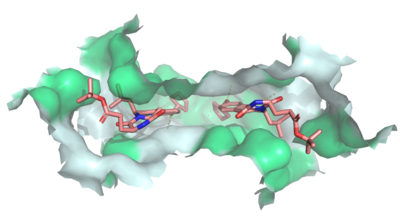Sandbox Reserved 1613
From Proteopedia
(Difference between revisions)
| Line 6: | Line 6: | ||
==ABC Transporter Family== | ==ABC Transporter Family== | ||
In the 1990's, [https://en.wikipedia.org/wiki/ATP-binding_cassette_transporter ABC binding cassette transporters] became the subject of much discussion as many were found to have links to the inhibition of anti-cancer therapies. All 48 members of the family were studied and several structural aspects were found to be important to the characterization of [https://en.wikipedia.org/wiki/Transport_protein transporters] in this family. The first was the presence of two [https://en.wikipedia.org/wiki/Nucleotide nucleotide] binding [https://en.wikipedia.org/wiki/Protein_domain domains] (NBD) located in the cytoplasm of all cells which bound and [https://en.wikipedia.org/wiki/Hydrolysis hydrolyzed] [https://en.wikipedia.org/wiki/Adenosine_triphosphate ATP], providing the necessary energy for [https://en.wikipedia.org/wiki/Membrane_transport transport] of the [https://en.wikipedia.org/wiki/Substrate_(chemistry) substrate] to occur. In all 7 subfamilies (A-G) of the ABC family, the NBD's are greatly conserved. Each transporter of this family is made unique by the structure and form of their specific transmembrane binding domain (TMD). Each of the 48 transporters have 2 transmembrane domains which work to recognize and transport the substrates across the [https://en.wikipedia.org/wiki/Cell_membrane plasma membrane] and out of the cell. The [https://en.wikipedia.org/wiki/Amino_acid residues] in the TMD provide the transporters each with specific substrates which they can transport. They also allow for the coupling of transport with ATP hydrolysis to transport molecules regardless of the concentration gradient. | In the 1990's, [https://en.wikipedia.org/wiki/ATP-binding_cassette_transporter ABC binding cassette transporters] became the subject of much discussion as many were found to have links to the inhibition of anti-cancer therapies. All 48 members of the family were studied and several structural aspects were found to be important to the characterization of [https://en.wikipedia.org/wiki/Transport_protein transporters] in this family. The first was the presence of two [https://en.wikipedia.org/wiki/Nucleotide nucleotide] binding [https://en.wikipedia.org/wiki/Protein_domain domains] (NBD) located in the cytoplasm of all cells which bound and [https://en.wikipedia.org/wiki/Hydrolysis hydrolyzed] [https://en.wikipedia.org/wiki/Adenosine_triphosphate ATP], providing the necessary energy for [https://en.wikipedia.org/wiki/Membrane_transport transport] of the [https://en.wikipedia.org/wiki/Substrate_(chemistry) substrate] to occur. In all 7 subfamilies (A-G) of the ABC family, the NBD's are greatly conserved. Each transporter of this family is made unique by the structure and form of their specific transmembrane binding domain (TMD). Each of the 48 transporters have 2 transmembrane domains which work to recognize and transport the substrates across the [https://en.wikipedia.org/wiki/Cell_membrane plasma membrane] and out of the cell. The [https://en.wikipedia.org/wiki/Amino_acid residues] in the TMD provide the transporters each with specific substrates which they can transport. They also allow for the coupling of transport with ATP hydrolysis to transport molecules regardless of the concentration gradient. | ||
| - | + | ===Specific Members of the Family=== | |
| + | As previously mentioned, 19 of the 48 members of the transporter family are involved in chemotherapeutic removal from the cell. Of these, three, <scene name='83/832939/Abcb1/1'>ABCB1</scene>, ABCG2 and ABCC1 were identified for further study and comparison of structure due to their function as multi-drug transporters. The differences in their structures provided valuable information for scientific research into their substrate binding processes. | ||
Revision as of 08:11, 21 April 2020
ABCG2 Transporter Protein
| |||||||||||
References
- ↑ Jackson SM, Manolaridis I, Kowal J, Zechner M, Taylor NMI, Bause M, Bauer S, Bartholomaeus R, Bernhardt G, Koenig B, Buschauer A, Stahlberg H, Altmann KH, Locher KP. Structural basis of small-molecule inhibition of human multidrug transporter ABCG2. Nat Struct Mol Biol. 2018 Apr;25(4):333-340. doi: 10.1038/s41594-018-0049-1. Epub, 2018 Apr 2. PMID:29610494 doi:http://dx.doi.org/10.1038/s41594-018-0049-1
- ↑ Manolaridis I, Jackson SM, Taylor NMI, Kowal J, Stahlberg H, Locher KP. Cryo-EM structures of a human ABCG2 mutant trapped in ATP-bound and substrate-bound states. Nature. 2018 Nov;563(7731):426-430. doi: 10.1038/s41586-018-0680-3. Epub 2018 Nov, 7. PMID:30405239 doi:http://dx.doi.org/10.1038/s41586-018-0680-3
- ↑ Fetsch PA, Abati A, Litman T, Morisaki K, Honjo Y, Mittal K, Bates SE. Localization of the ABCG2 mitoxantrone resistance-associated protein in normal tissues. Cancer Lett. 2006 Apr 8;235(1):84-92. doi: 10.1016/j.canlet.2005.04.024. Epub, 2005 Jun 28. PMID:15990223 doi:http://dx.doi.org/10.1016/j.canlet.2005.04.024
- ↑ Taylor NMI, Manolaridis I, Jackson SM, Kowal J, Stahlberg H, Locher KP. Structure of the human multidrug transporter ABCG2. Nature. 2017 Jun 22;546(7659):504-509. doi: 10.1038/nature22345. Epub 2017 May, 29. PMID:28554189 doi:http://dx.doi.org/10.1038/nature22345
- ↑ Cleophas MC, Joosten LA, Stamp LK, Dalbeth N, Woodward OM, Merriman TR. ABCG2 polymorphisms in gout: insights into disease susceptibility and treatment approaches. Pharmgenomics Pers Med. 2017 Apr 20;10:129-142. doi: 10.2147/PGPM.S105854., eCollection 2017. PMID:28461764 doi:http://dx.doi.org/10.2147/PGPM.S105854
- ↑ [ https://en.wikipedia.org/wiki/ABCG2 "ABCG2 -." Wikipedia, the Free Encyclopedia. Web. 20 Apr. 2020].
- ↑ Jackson SM, Manolaridis I, Kowal J, Zechner M, Taylor NMI, Bause M, Bauer S, Bartholomaeus R, Bernhardt G, Koenig B, Buschauer A, Stahlberg H, Altmann KH, Locher KP. Structural basis of small-molecule inhibition of human multidrug transporter ABCG2. Nat Struct Mol Biol. 2018 Apr;25(4):333-340. doi: 10.1038/s41594-018-0049-1. Epub, 2018 Apr 2. PMID:29610494 doi:http://dx.doi.org/10.1038/s41594-018-0049-1
Student Contributors
Shelby Skaggs, Samuel Sullivan, Jaelyn Voyles

